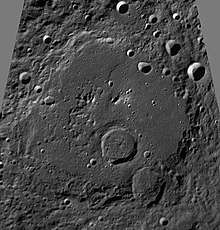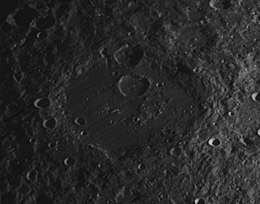Schwarzschild (crater)
Schwarzschild is a large lunar impact crater, approximately 211 kilometers (131 mi) in diameter. It is located in the northern part of the Moon's far side. The nearest craters of note are Seares to the northeast, and Gamow to the southeast. It was named after German physicist and astronomer Karl Schwarzschild (1873–1916).[1]
 LRO mosaic | |
| Coordinates | 70.1°N 121.2°E |
|---|---|
| Diameter | 211.42 km |
| Depth | Unknown |
| Colongitude | 249° at sunrise |
| Eponym | Karl Schwarzschild |
The somewhat irregular outer rim of Schwarzschild has been overlain by many smaller impact craters, including most notably Schwarzschild K across the southeastern face and Schwarzschild D on the northeastern rim. The rim is roughly circular in form, with an outward bulge along the southwestern side. The rim has been softened and modified by impact erosion, particularly to the northeast. Just to the northeast of Schwarzschild K is a short chain of small craters lying across the rim and inner wall of Schwarzschild.
The inner floor of Schwarzschild is relatively level by comparison with the rugged terrain outside, and is particularly flat in the north-northeastern half. There is a region of low, irregular ridges to the west of the midpoint. Lying in the southeastern part of the floor is the satellite crater Schwarzschild L, and surrounding this interior crater is an outer rampart formed from the ejecta material during its formation.
Satellite craters

By convention these features are identified on lunar maps by placing the letter on the side of the crater midpoint that is closest to Schwarzschild.
| Satellite Feature | Latitude | Longitude | Diameter | Ref |
|---|---|---|---|---|
| A | 78.7° N | 124.0° E | 44.65 km | WGPSN |
| D | 71.9° N | 132.4° E | 21.89 km | WGPSN |
| K | 67.5° N | 125.0° E | 40.97 km | WGPSN |
| L | 69.3° N | 122.1° E | 45.38 km | WGPSN |
| Q | 66.3° N | 108.9° E | 17.52 km | WGPSN |
| S | 67.8° N | 104.7° E | 16.78 km | WGPSN |
| T | 69.9° N | 107.7° E | 15.61 km | WGPSN |
See also
- Asteroid 837 Schwarzschilda
References
- "Schwarzschild Crater". Gazetteer of Planetary Nomenclature. USGS Astrogeology Research Program.
- Andersson, L. E.; Whitaker, E. A. (1982). NASA Catalogue of Lunar Nomenclature. NASA RP-1097.CS1 maint: ref=harv (link)
- Blue, Jennifer (July 25, 2007). "Gazetteer of Planetary Nomenclature". USGS. Retrieved 2007-08-05.CS1 maint: ref=harv (link)
- Bussey, B.; Spudis, P. (2004). The Clementine Atlas of the Moon. New York: Cambridge University Press. ISBN 978-0-521-81528-4.CS1 maint: ref=harv (link)
- Cocks, Elijah E.; Cocks, Josiah C. (1995). Who's Who on the Moon: A Biographical Dictionary of Lunar Nomenclature. Tudor Publishers. ISBN 978-0-936389-27-1.CS1 maint: ref=harv (link)
- McDowell, Jonathan (July 15, 2007). "Lunar Nomenclature". Jonathan's Space Report. Retrieved 2007-10-24.CS1 maint: ref=harv (link)
- Menzel, D. H.; Minnaert, M.; Levin, B.; Dollfus, A.; Bell, B. (1971). "Report on Lunar Nomenclature by the Working Group of Commission 17 of the IAU". Space Science Reviews. 12 (2): 136–186. Bibcode:1971SSRv...12..136M. doi:10.1007/BF00171763.CS1 maint: ref=harv (link)
- Moore, Patrick (2001). On the Moon. Sterling Publishing Co. ISBN 978-0-304-35469-6.CS1 maint: ref=harv (link)
- Price, Fred W. (1988). The Moon Observer's Handbook. Cambridge University Press. ISBN 978-0-521-33500-3.CS1 maint: ref=harv (link)
- Rükl, Antonín (1990). Atlas of the Moon. Kalmbach Books. ISBN 978-0-913135-17-4.CS1 maint: ref=harv (link)
- Webb, Rev. T. W. (1962). Celestial Objects for Common Telescopes (6th revised ed.). Dover. ISBN 978-0-486-20917-3.CS1 maint: ref=harv (link)
- Whitaker, Ewen A. (1999). Mapping and Naming the Moon. Cambridge University Press. ISBN 978-0-521-62248-6.CS1 maint: ref=harv (link)
- Wlasuk, Peter T. (2000). Observing the Moon. Springer. ISBN 978-1-85233-193-1.CS1 maint: ref=harv (link)